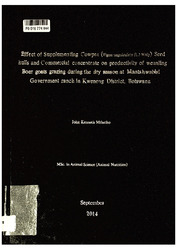Effect of ssupplementing ccowpea (Vigna ungulculata (L.) Walp) seed hulls and Commercial concentrate on productivity of weanling Boer goats grazing during the dry season at Mantshwabisl Government ranch in Kweneng District, Botswana
Abstract
The study was carried out during the dry season between June and August of 2013 to evaluate chemical composition, in vitro dry matter digestibility (IVDMD), feed intake and performance by weanling Boer goats supplemented with cowpea seed hulls (CSH) and commercial concentrate/feed (CF) with natural pasture as basal diet. Weanling Boer goats (n=36) were assigned 3 treatments comprising of 4 animals each (2 bucklings and 2 females) replicated three times in a completely randomized design (CRD) matrix. The goats aged between 1 and 2 years with initial body mass ranging from 17.5 - 38 kg (mean ± SD, 26.32 ± 6.36,). The animals were fed as follows: diet 1 was the non-supplemented natural browse/pasture (control), diet 2 was the natural browse/pasture supplemented with commercial concentrate and diet 3 was the natural browse/pasture supplemented with cowpea seed hulls. Each of the supplemented diets was fed at the rate of 300 g per goat per day at 08:30 a.m. before goats could be released to graze/browse on the natural pasture within the paddock. Crude protein (CP) contents (g/100 g DM) in the Commercial concentrate was lighest (P<0.05) followed by Cowpea seed hulls, browse species and grasses, rhe NDF, ADF and ADL were lowest (P<0.05) in the commercial concentrate followed by cowpea seed hulls, browse species and grasses, respectively. initial body weights of goats grazed and supplemented with commercial concentrate and goats grazed without supplementation were similar (P>0.05); the mats grazed and supplemented with cowpea seed hulls had lowest (P<0.05) weight. However, at the end of the study goats on natural pasture supplemented……..
Collections
- Theses and Dissertations [133]

